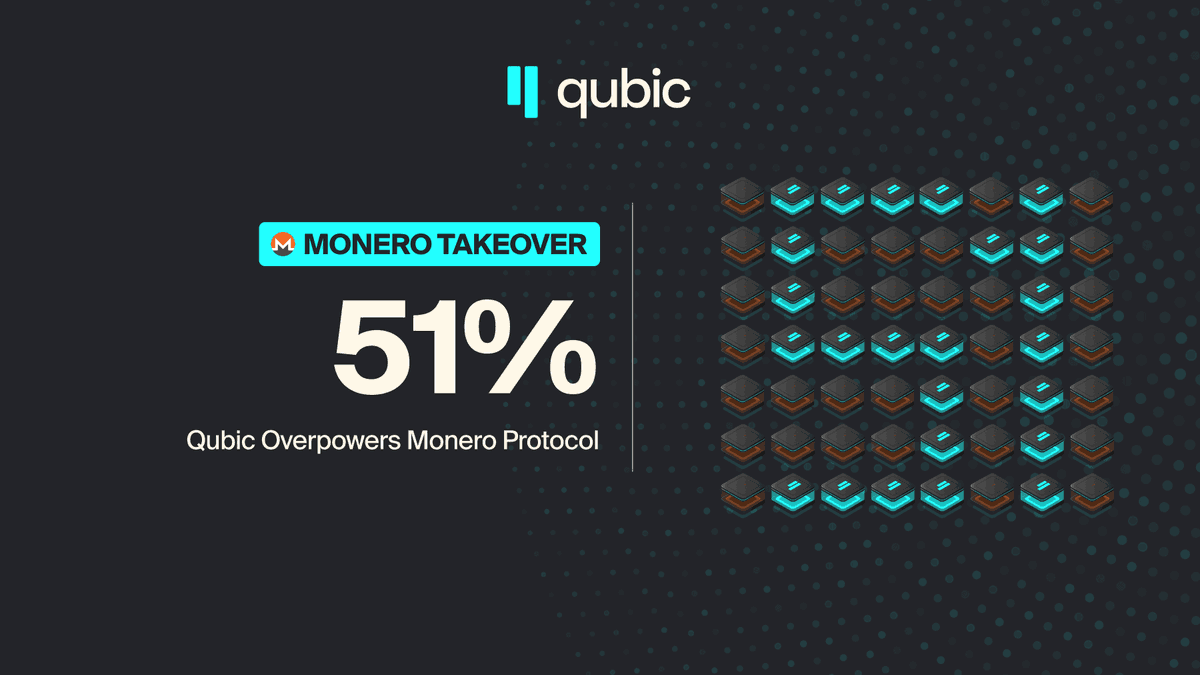Qubic computing power is the AGI brain, and the oracle is the eyes.
How could the UPoW consensus mechanism have security issues?
Monero $XMR, a leading privacy coin with a market cap of 6 billion, was surprisingly attacked by a small project @_Qubic_ with only a 300 million market cap? WTF, it's not because of how advanced the technology is, but because this situation is just absurd. Let me explain:
—— Who is Qubic?
Before diving into this magical story, we need to understand what Qubic is all about.
The founder of Qubic is Sergey Ivancheglo, known in the community as Come-from-Beyond. He is a tech fanatic—he created the first PoS blockchain NXT and developed the first DAG architecture IOTA. In 2022, Qubic launched its mainnet, claiming to achieve three things: to build an ultra-fast chain capable of 15.5 million transactions per second (20,000 times faster than Visa), to turn mining power into AI training power, and ultimately to achieve AGI (Artificial General Intelligence) by 2027 (something even OpenAI wouldn't dare to claim). Sounds magical and ridiculous, right? Why such grand ambitions?
It's well-known that traditional POW mining has been criticized for wasting electricity, as most mining mechanisms involve miners using power-consuming computing power to solve mathematical problems to claim reward blocks, essentially wasting computing power for rewards.
Qubic's new consensus is Useful Proof of Work (UPow), which allows miners to mine on a POW chain while also training their AI system AIGarth under the coordination of a contractor, meaning one unit of computing power can earn two incomes.
This is why they could easily entice Monero miners, as the returns for miners reached up to three times that of directly mining XMR. Just think about it, miners can double-dip, and in the face of "interests," what loyalty can there be?
Now, having read this, the underlying logic of Monero being attacked by vampires has been explained without any technical content.
—— Let’s clarify why it’s Monero and not Bitcoin
The answer lies in the difference in mining methods.
Bitcoin uses ASIC miners, which are custom machines specifically designed to mine BTC; they can only solve SHA-256 mathematical problems and cannot mine coins with similar algorithms. However, the problem is that the competition for Bitcoin mining power is intense, and miners are stretched thin (operating 24/7), and there’s no way to train AI with ASICs.
Monero, on the other hand, uses the RandomX algorithm, which allows mining with general-purpose CPUs. This means its miners can mine today, train AI tomorrow, and render videos the day after, effectively multitasking.
Qubic's cleverness lies in targeting CPU miners, allowing them to "use one machine for two purposes," which led to this 51% power attack or control incident. In contrast, Bitcoin's moat is quite stable; miners are trapped with limited ASIC miners, forced to stick to Bitcoin.
—— Computing power has become mercenaries
So how scary is this situation? It tears apart the last bit of cover for some POW chains, because we always say that "computing power" is the moat of a chain—the greater the computing power, the more secure it is. But Qubic's shocking experiment tells us: for coins mined with CPU/GPU, computing power is like mercenaries; whoever pays more gets their loyalty.
What’s even more intriguing is that after proving it could take down Monero, Qubic voluntarily withdrew. Why? They feared completely crashing Monero and affecting their own profits. Because a significant portion of the threefold returns still comes from mining XMR, $QUBIC is merely an additional token reward. If Monero crashes, Qubic can't just walk away unscathed. It’s better to gracefully withdraw, create a sensational marketing event, and humiliate the once staunch supporters of POW. This feeling of "I can kill you but won’t" is reminiscent of their AGI slogan, revealing a sense of reckless abandon.
—— Is AI the true grave digger of POW?
However, aside from the impact of the Monero incident, this is actually a significant negative for most general-purpose hardware POW chains, as if these POW chains are to fail, it may not be POS that kills them, but AI.
Why do I say this? Previously, computing power was "solid"; everyone focused on their own livelihoods. In the AI era, computing power has become completely "liquid"; CPU and GPU power flows like water, only going to places with higher returns, and the "miners" they relied on for survival might one day unite and revolt.
Although Qubic isn’t the villain, once the experiment succeeds, it’s inevitable that some competitors will use this method for malicious attacks, such as shorting a coin and then renting 51% of the computing power to attack, profiting after the coin price plummets. The paths before such chains are two: either like BTC, weld miners to their positions, or continue using CPU/GPU mining and pray not to be targeted.
Honestly, there are quite a few such coins: Grin, Beam, Haven Protocol, ETC, RVN, Conflux... So you see, this isn’t just a problem for one or two coins, but the entire CPU/GPU mining ecosystem is hanging on the edge of a cliff.
The deadly part is that the demand for AI computing power is growing exponentially, and with so many AI computing power aggregation platforms emerging, if they all come to disrupt the market with sky-high prices and platform incentives to buy computing power, many POW chains' security defenses may collapse.
—— An ironic paradox
The reason I say this is absurd is that Qubic itself is an AI chain. Even if it withdraws from the so-called attack on Monero, it cannot avoid self-inflicted damage. The logic is simple: any AI chain that requires computing power should not use PoW for consensus. Because if computing power is used to maintain security, AI cannot be trained; if computing power is used to train AI, the chain becomes insecure.
Thus, most AI projects use PoS, like Bittensor, or reputation systems, like Render; hardly anyone dares to touch POW. Everyone knows this, yet Qubic foolishly showcased its own Achilles' heel.
Qubic's recent antics, on the surface, appear to be a technical event, but fundamentally, it serves as a lesson for the entire crypto industry: in an era of freely flowing computing power, loyalty is a luxury, and most POW chains cannot afford that price.
Qubic has demonstrated that traditional PoW can be easily shattered by economic incentives. Although it claims to be "Useful PoW," it essentially relies on these "mercenary" computing powers that can be bought by higher bidders at any time.
Revolutionaries may also be overthrown by the next revolutionaries.
Note: Beyond the absurdity and the unknown panic of some POW chains, two facts can be confirmed: 1. BTC is indeed impressive; 2. @VitalikButerin truly has foresight.
I’m just providing a brief overview; I look forward to @evilcos sharing more technical details.

15.6K
3
The content on this page is provided by third parties. Unless otherwise stated, OKX is not the author of the cited article(s) and does not claim any copyright in the materials. The content is provided for informational purposes only and does not represent the views of OKX. It is not intended to be an endorsement of any kind and should not be considered investment advice or a solicitation to buy or sell digital assets. To the extent generative AI is utilized to provide summaries or other information, such AI generated content may be inaccurate or inconsistent. Please read the linked article for more details and information. OKX is not responsible for content hosted on third party sites. Digital asset holdings, including stablecoins and NFTs, involve a high degree of risk and can fluctuate greatly. You should carefully consider whether trading or holding digital assets is suitable for you in light of your financial condition.


